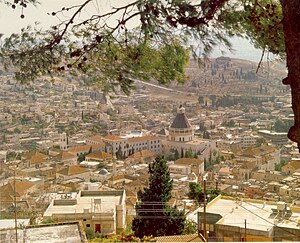
René’s response has been reformatted and posted here with permission:
Obviously, the question of Nazareth archaeology is my special bailiwick and, to my knowledge, no one has specifically countered Ehrman regarding his pages 191-97. I can say here that Ehrman is evasive, tendentious and, of course, entirely wrong.
- He is evasive by casually ignoring vital elements of my case (e.g., he doesn’t even mention oil lamps, all of which date to the common era at Nazareth).
- He is tendentious
- by stressing extra-evidentiary elements (such as my lack of credentials–p. 194),
- by focussing on irrelevancies (kokh tombs were expensive and not used by “poor people”),
- and by grossly mischaracterizing actual evidence.
The boondoggle regarding Yardena Alexandre’s 165 coins (p. 195) is a case in point and is getting entirely out of hand.
The Israel Antiquities Authority (IAA) report Alexandre sent me in May, 2006 regarding her Mary’s Well excavation makes no mention of coins other than “many 14th-15th century small denomination coins.” It is inconceivable to me that coins dating “to the Hellenistic, Hasmonean, and early Roman period, that is, the days of Jesus” (DJE 195) would have been omitted from Alexandre’s report to the IAA. Furthermore, such a coin profile conflicts with the remaining evidence from Nazareth.
Nevertheless, such coins have subsequently been claimed, beginning with the Nazareth Village Farm report (BAIAS 2007, p.40) authored by Stephen Pfann and others. There, Pfann writes that a report on these early coins from Alexandre is “forthcoming” but, to my knowledge, no such report has appeared (now five years on). In his “Reply to Salm” in BAIAS 2008:106, Pfann and Rapuano write that Alexandre has provided a written statement to them attesting to such early coins in her 1997-98 excavation. Evidently, Pfann and the tradition are running with this. Ehrman now also mentions this: “Alexandre has verbally confirmed that in fact it is the case: there were coins in the collection that date to the time prior to the Jewish uprising” (196).
So, the plot thickens. We have “evidence” that is not published but is being passed from one scholar to another and must be taken on faith. Of course, had I admitted unverifiable evidence ten years ago, my Nazareth book would never have been written.
Finally, Ehrman is simply wrong in his conclusions regarding Nazareth. He thinks that not having excavated the Nazareth valley floor immediately obviates my argument — for that is where I maintain the settlement existed. But — and I personally emailed this to Ehrman in July 2011 — “What has been excavated at Nazareth is more than ample to infer a dating for the people who lived on the valley floor, for they of course are the ones who built the tombs and agricultural installations on the hillsides.” He ignores this in his book.
Ehrman closes by making a big deal of the ‘Nazareth house of the time of Jesus’ excavation (Alexandre again) which news broke in the press in Dec. 2009. Once again, we have no written report, only press releases. Furthermore, the excavation site was quickly covered over (by a religious tourist venue) making further digging impossible.
Do you smell a rat? Maybe half a dozen rats?
René

If you enjoyed this post, please consider donating to Vridar. Thanks!

Its a dying shame bart does not examine and reveal to his audience that just about everything about the jesus story is a lie, fabrication or unistorical. He should really edit a gospel leaving out all the creative writings. It will be a quick write..
René, you may have seen this, but Bart revisits the Nazareth question in an interview:
http://www.patheos.com/blogs/bibleandculture/2012/06/10/bart-ehrman-on-did-jesus-exist-part-six/
“As background: many mythicists have claimed that the town of Nazareth in fact did not exist in Jesus day. On that ground, they argue that Jesus therefore must have been made up. But the logic of this statement involves a complete non sequitur.”
“The other problem, as I spell out at length in my book, is that the mythicists who claim that Nazareth did not exist in Jesus’ day are completely wrong. It did exist. We have indisputable archaeological proof. Ask any archaeologist of Palestine –absolutely any of them. Archaeologists, for example, have uncovered a farm in Nazreth that was functioning at the time of Jesus; and recently they have uncovered a house that was standing at the time; and they have found coins that were deposited there at the time. There is absolutely no doubt that Nazareth existed at the time. It wasn’t a big place. It wasn’t an impressive place. It was a fairly miserable little place. But it existed. I give some of the evidence in my book.”
Nazareth did not exist at all. Studying history is more important than you think. The first pilgrim to Palestina was ofcourse Constantine’s mother, no doubt accompanied by some bishops. They were looking for Nazareth but it was not there. They searched and searched but nothing. In the end they APPOINTED some old village or houses or whatever to become Nazareth. You simpy place a sign by the road. Since then (326) there is a so-called Nazareth, which is were everybody is digging. That is a spot only appointed as Nazareth by the church in 326 on behalf of Constantine’s mother. BECAUSE IT WAS NOT THERE. There never was a Nazareth. Reading prevents digging for nothing and all that argueing and archeology.
Yoap.
I sometimes think that more myths have been told about Helena than she herself manufactured. If you read studies about Helena I don’t think you will find your claim here about her role in relation to Nazareth to have any factual basis. Why not read Salm’s book and also Taylor’s Christians and the Holy Places?